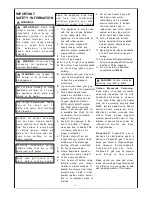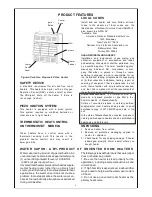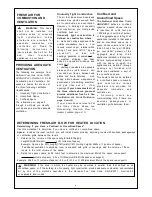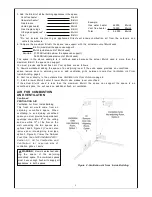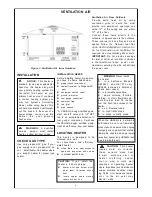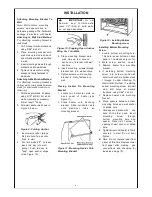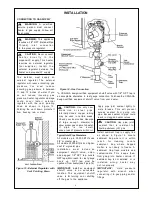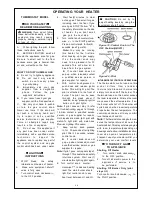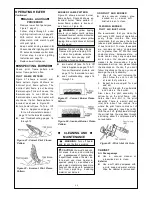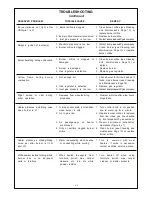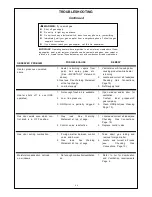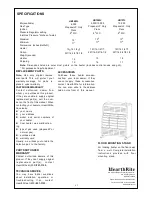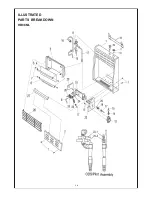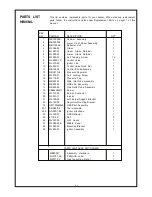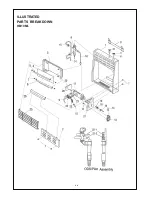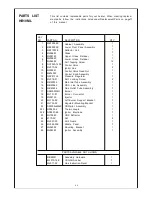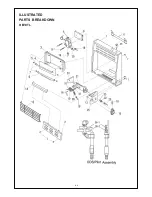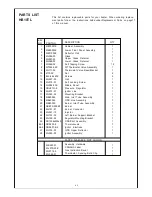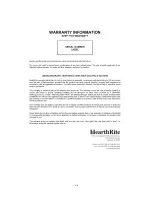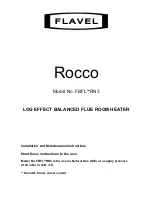
1 0
Figure 15 -Equipment Shutoff Valve
INSTALLATION
CHECKING GAS
CONNECTIONS
WARNING:
Test all gas piping
and connections for leaks after
installing or servicing. Correct
all leaks at once.
WARNING:
Never use an
open flame to check for a leak.
Apply a mixture of liquid soap
and water to all joints. Bubbles
forming show a leak. Correct all
leaks at once.
Pressure Testing Gas Supply
Piping System
Test Pressures In Excess Of
1/2 PSIG (3.5 K Pa)
1. Disconnect appliance with its
appliance main gas valve
(control valve) and equipment
shutoff valve from gas supply
piping system. Pressures in
excess of 1/2 psig will damage
heater regulator.
2. Cap off open end of gas pipe
where equipment shutoff valve
was connected.
3. Pressurize supply piping
s y s t e m b y e i t h e r u s i n g
compressed air or opening
propane/LP supply tank valve.
4. Check all joints of gas supply
piping system. Apply mixture of
liquid soap and water to gas
joints. Bubbles forming show
a leak.
5. Correct all leaks at once.
6. Reconnect heater and equipment
shutoff valve to gas supply. Check
reconnected fittings for leaks.
Test Pressures Equal To or
Less Than 1/2 PSIG (3.5 K Pa)
1. Close equipment shutoff valve
(see Figure 15).
2. Pressurize supply piping system
by either using compressed air
or opening propane/LP supply
tank valve.
3. Check all joints from gas meter to
equipment shutoff valve (see
Figure 16). Apply mixture of liquid
soap and water to gas joints.
Bubbles forming show a leak.
4. Correct all leaks at once.
Pressure Testing Heater Gas
Connections
1. Open equipment shutoff valve
(see Figure 15).
2. Open propane/LP supply tank
valve.
3. Make sure control knob of
heater is in the OFF position.
4. Check all joints from equipment
shutoff valve to control valve
(see Figure 16 ). Apply mixture of
liquid soap and water to gas
joints. Bubbles forming show
a leak.
5. Correct all leaks at once.
6. Light heater (see Operating
Heater, pages 10 and 11 for
non-thermostat models or
page 12 for thermostat model).
Check the rest of the internal
joints for leaks.
7. Turn off heater (see To Turn Off
Gas to Appliance, page 11 for
non-thermostat models or page
12 for thermostat model).
8. Replace lower front panel.
OPERATING YOUR HEATER
NON-THERMOSTAT MODEL
!
FOR YOUR SAFETY
!
READ BEFORE LIGHTING
WARNING:
If you do not
f o l l o w t h e s e i n s t r u c t i o n s
exactly, a fire or explosion may
r e s u l t c a u s i n g p r o p e r t y
damage, personal injury or
loss of life.
A When lighting the pilot, follow
these instructions exactly.
B. BEFORE LIGHTING smell all
around the appliance area for
gas. Be sure to smell next to
the floor because some gas is
heavier than air and will settle
on the floor .
WHAT TO DO IF YOU SMELL GAS
!
Do not try to light any appliance.
!
Do not touch any electric switch;
do not use any phone in your
building.
!
Immediately call your gas
supplier from a neighbor’s
phone. Follow the gas
supplier’s instructions.
!
If you cannot reach your gas
supplier, call the fire department.
C. Use only your hand to push in
or turn the gas control knob.
Never use tools. If the knob
will not push in or turn by
hand, don’t try to repair it, call
a qualified service technician or
gas supplier. Force or attempted
repair may result in a fire or
explosion.
D. Do not use this appliance if any
p a r t h a s b e e n u n d e r w a t e r .
Immediately call a qualified
service technician to inspect
the appliance and to replace
any part of the control system
and any gas control which has
been under water.
Figure 16 -Checking Gas Joints
In the State of Massachusetts the
gas cock must be a T handle type.
The State of Massachusetts
requires that a flexible appliance
connector cannot exceed three
feet in length.
Содержание HB06ML-1
Страница 18: ...1 8 ILLUSTRATED PARTS BREAKDOWN HB06ML ...
Страница 20: ...2 0 ILLUSTRATED PARTS BREAKDOWN HB10ML ...
Страница 22: ...2 2 ILLUSTRATED PARTS BREAKDOWN HB10TL ...
Страница 24: ...2 4 ...


